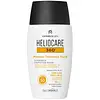What's inside
What's inside
 Key Ingredients
Key Ingredients

 Benefits
Benefits

 Concerns
Concerns

 Ingredients Side-by-side
Ingredients Side-by-side

Water
Skin ConditioningDimethicone
EmollientIsododecane
EmollientC12-15 Alkyl Benzoate
AntimicrobialHydrogenated Polydecene
EmollientTitanium Dioxide
Cosmetic ColorantZinc Oxide
Cosmetic ColorantButyloctyl Salicylate
Skin ConditioningAlumina
AbrasiveStyrene/Acrylates Copolymer
Phenethyl Benzoate
EmollientPEG-9 Polydimethylsiloxyethyl Dimethicone
EmulsifyingNylon-12
Polypodium Leucotomos Leaf Extract
Skin ProtectingFerulic Acid
AntimicrobialCaffeic Acid
AntioxidantPhysalis Angulata Extract
Skin ProtectingCaprylyl Glycol
EmollientMelanin
Skin ProtectingCamellia Sinensis Extract
AntioxidantPlankton Extract
Skin Conditioning3-O-Ethyl Ascorbic Acid
Skin ConditioningIsohexadecane
EmollientHydrogen Dimethicone
Phenylpropanol
MaskingPolyhydroxystearic Acid
EmulsifyingMagnesium Sulfate
Tocopheryl Acetate
AntioxidantDimethicone/PEG-10/15 Crosspolymer
Propanediol
SolventTriethoxycaprylylsilane
Propylene Carbonate
SolventCaprylic/Capric Triglyceride
MaskingPanthenyl Triacetate
Butylene Glycol
HumectantPropylene Glycol
HumectantArginine
MaskingEthyl Linoleate
EmollientOleyl Alcohol
EmollientPentylene Glycol
Skin ConditioningOxothiazolidine
Skin ProtectingDipropylene Glycol
HumectantSodium Citrate
BufferingPalmitoyl Hydroxypropyltrimonium Amylopectin/Glycerin Crosspolymer
Skin Conditioning1,2-Hexanediol
Skin ConditioningLecithin
EmollientSodium Benzoate
MaskingTocopherol
AntioxidantHydrogenated Lecithin
EmulsifyingPhenoxyethanol
PreservativeCI 77492
Cosmetic ColorantCI 77491
Cosmetic ColorantCI 77499
Cosmetic ColorantWater, Dimethicone, Isododecane, C12-15 Alkyl Benzoate, Hydrogenated Polydecene, Titanium Dioxide, Zinc Oxide, Butyloctyl Salicylate, Alumina, Styrene/Acrylates Copolymer, Phenethyl Benzoate, PEG-9 Polydimethylsiloxyethyl Dimethicone, Nylon-12, Polypodium Leucotomos Leaf Extract, Ferulic Acid, Caffeic Acid, Physalis Angulata Extract, Caprylyl Glycol, Melanin, Camellia Sinensis Extract, Plankton Extract, 3-O-Ethyl Ascorbic Acid, Isohexadecane, Hydrogen Dimethicone, Phenylpropanol, Polyhydroxystearic Acid, Magnesium Sulfate, Tocopheryl Acetate, Dimethicone/PEG-10/15 Crosspolymer, Propanediol, Triethoxycaprylylsilane, Propylene Carbonate, Caprylic/Capric Triglyceride, Panthenyl Triacetate, Butylene Glycol, Propylene Glycol, Arginine, Ethyl Linoleate, Oleyl Alcohol, Pentylene Glycol, Oxothiazolidine, Dipropylene Glycol, Sodium Citrate, Palmitoyl Hydroxypropyltrimonium Amylopectin/Glycerin Crosspolymer, 1,2-Hexanediol, Lecithin, Sodium Benzoate, Tocopherol, Hydrogenated Lecithin, Phenoxyethanol, CI 77492, CI 77491, CI 77499
Water
Skin ConditioningEthylhexyl Salicylate
UV AbsorberEthylhexyl Methoxycinnamate
UV AbsorberHomosalate
Skin ConditioningGlycerin
HumectantC12-15 Alkyl Benzoate
AntimicrobialButyl Methoxydibenzoylmethane
UV AbsorberCaprylic Acid
CleansingPropylene Glycol
HumectantStearic Acid
CleansingGlycol
HumectantGlycyrrhiza Glabra Root Extract
BleachingAlpha-Arbutin
AntioxidantPanthenol
Skin ConditioningPotassium Cetyl Phosphate
EmulsifyingDiacetyl Boldine
Skin ConditioningInulin Lauryl Carbamate
Emulsion StabilisingPhenoxyethanol
PreservativeXanthan Gum
EmulsifyingLactic Acid
BufferingEthylhexylglycerin
Skin ConditioningTetrasodium EDTA
Water, Ethylhexyl Salicylate, Ethylhexyl Methoxycinnamate, Homosalate, Glycerin, C12-15 Alkyl Benzoate, Butyl Methoxydibenzoylmethane, Caprylic Acid, Propylene Glycol, Stearic Acid, Glycol, Glycyrrhiza Glabra Root Extract, Alpha-Arbutin, Panthenol, Potassium Cetyl Phosphate, Diacetyl Boldine, Inulin Lauryl Carbamate, Phenoxyethanol, Xanthan Gum, Lactic Acid, Ethylhexylglycerin, Tetrasodium EDTA
 Reviews
Reviews

Ingredients Explained
These ingredients are found in both products.
Ingredients higher up in an ingredient list are typically present in a larger amount.
C12-15 Alkyl Benzoate is made up of Benzoic Acid and long chain alcohols. It has a low molecular weight.
C12-15 Alkyl Benzoate is an emollient and texture enhancer. Due to its solubility, it is often used in sunscreens to help evenly distribute active ingredients.
As an emollient, C12-15 Alkyl Benzoate helps soften and hydrate your skin. Emollients create a film on your skin that traps moisture within.
This ingredient has been reported to cause eye irritation.
Learn more about C12-15 Alkyl BenzoatePhenoxyethanol is a preservative that has germicide, antimicrobial, and aromatic properties. Studies show that phenoxyethanol can prevent microbial growth. By itself, it has a scent that is similar to that of a rose.
It's often used in formulations along with Caprylyl Glycol to preserve the shelf life of products.
Propylene Glycol is an odorless, colorless liquid. As a humectant, it helps skin retain moisture. It also aids in delivering active ingredients.
Another role of this ingredient is preventing a product from melting or freezing. Propylene glycol also adds antimicrobrial properties to a product, elongating product lifespan.
This ingredient is considered an organic alcohol and commonly added into both cosmetics and foods.
Those with sensitive skin or conditions may develop a rash when using this ingredient.
Learn more about Propylene GlycolWater. It's the most common cosmetic ingredient of all. You'll usually see it at the top of ingredient lists, meaning that it makes up the largest part of the product.
So why is it so popular? Water most often acts as a solvent - this means that it helps dissolve other ingredients into the formulation.
You'll also recognize water as that liquid we all need to stay alive. If you see this, drink a glass of water. Stay hydrated!
Learn more about Water